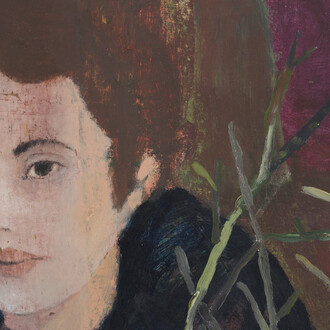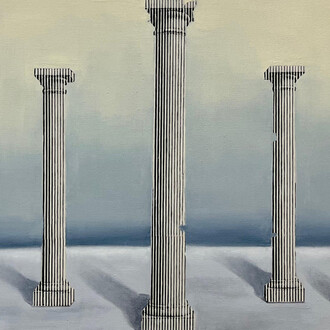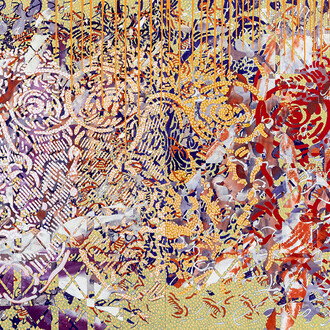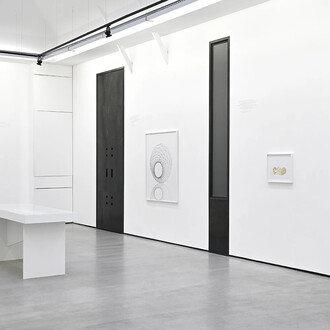In the Spring of 2025, Fondation Louis Vuitton is inviting David Hockney, one of the most influential artists of the 20th and 21st centuries, to take over the entire building for an exhibition that will be exceptional in its scale and its originality. The exhibition, which will be held from 9 April to 1 September 2025, will bring together more than 400 of his works (from 1955 to 2025) including paintings from international, institutional, and private collections, as well as works from the artist’s own studio and Foundation. There will be works in a variety of media including oil and acrylic painting, ink, pencil and charcoal drawing, digital art (works on iPhone, iPad, photographic drawings...) and immersive video installations.
David Hockney has been personally involved in every aspect of the exhibition and has, together with his partner and studio manager Jean-Pierre Gonçalves de Lima, chosen to focus particularly on the past 25 years whilst also including the iconic early works, offering visitors a rare insight into his creative universe, spanning seven decades. The artist has participated in the composition of each sequence and the layout of each space, in a permanent dialogue with his assistant Jonathan Wilkinson.
Commenting on the exhibition, he said: “This exhibition means an enormous amount because it is the largest exhibition I’ve ever had – 11 rooms in the Fondation Louis Vuitton. Some of the most recent paintings I’m working on now will be included in it, and I think it’s going to be very good”.
The exhibition, David Hockney, 25, will show how the artist has continually renewed both his subjects and his mode of expression over these years. David Hockney’s ability to reinvent his art with the use of new media is exceptional – first a draughtsman, then master of all academic techniques, he is today a champion of new technologies.
As an introduction, the exhibition will begin, at the pond level, with a selection of emblematic works from the 1950s to the 1970s – including Hockney’s beginnings in Bradford (portrait of my father, 1955), his time in London and then California. The swimming pool – a signature theme for the artist – appears in A bigger splash, 1967 and Portrait of an artist (pool with two figures), 1972. His series of double portraits is represented by two major works: Mr. and Mrs. Clark and Percy, 1970-1971 and Christopher Isherwood and Don Bachardy, 1968.
Nature becomes increasingly important in David Hockney’s work in the decade 1980 to 1990 – as illustrated by A Bigger Grand Canyon, 1998 – before he returns to Europe to continue his exploration of familiar landscapes.
The core of the exhibition will concentrate on the past 25 years, spent mainly in Yorkshire, Normandy, and London. This period, in the exhibition, opens with a celebration of the Yorkshire landscape: the artist paints a hawthorn bush in a spectacular explosion of spring (May blossom on the Roman Road, 2009); his observation of the changing seasons culminates in the monumental winter landscape Bigger trees near warter or/ou peinture sur le motif pour le nouvel age post-photographique, 2007, generously loaned by the Tate.
During the same period, David Hockney painted friends and relatives in acrylic or on iPad, while also working on self-portraits. The exhibition will feature some 60 portraits (Gallery 4), which will be shown alongside his “portraits of flowers”. Created on a digital tablet but displayed in traditional frames, the works have an intriguing effect. This is evident in 25th June 2022, looking at the flowers (framed), 2022, where they are shown together on the wall.
The Fondation’s 1st Floor (Galleries 5 to 7) will be entirely dedicated to Normandy and its landscapes. The 220 for 2020 series, completed exclusively on iPad, will be presented in an entirely new installation in Gallery 5. Day after day, season after season, the artist captures the light variations. A series of acrylic paintings is on display in Gallery 6, featuring a highly singular treatment of the sky, animated by vibrant touches, that subtly evoke the work of Van Gogh. In Gallery 7, a panorama of 24 ink drawings (La grande cour, 2019) echoes the Bayeux Tapestry.
Finally, a series of reproductions, dating back to the Quattrocento and serving as important references for the artist, will open the display on the uppermost floor (The great wall, 2000). Hockney’s painting draws on global art-historical references dating from Antiquity to the present day. In the exhibition, his works focus on European paintings, including works from the early Renaissance, the Flemish Masters and modern art. The first part of the display in Gallery 9 will showcase this dialogue with Fra Angelico, Claude Lorrain, Cézanne, Van Gogh, Picasso... From there, we will enter the artist’s studio, transformed into a dance hall – mirroring David Hockney’s own home where musicians and dancers are regularly invited to perform.
Passionate about opera, David Hockney has been eager to reinterpret the set designs he has been creating since the 1970s in a new polyphonic creation, in conjunction with 59 Studio. Visitors will be immersed in this musical and visual piece inside the Fondation’s most monumental exhibition space (Gallery 10).
The final room of the exhibition, which will be more intimate, will unveil David Hockney’s most recent works, painted in London, where the artist has been residing since July 2023 (Gallery 11). These particularly enigmatic paintings are inspired by Edvard Munch and William Blake: After Munch: less is known than people think, 2023, and After Blake: less is known than people think, 2024, in which astronomy, history and geography cross paths with spirituality, according to the artist who has also chosen to show his latest self-portrait in this final room.
















